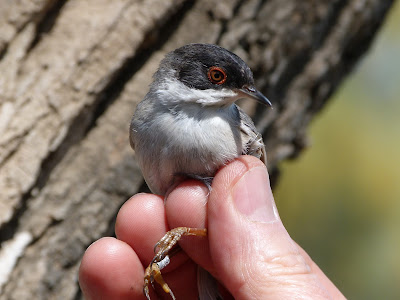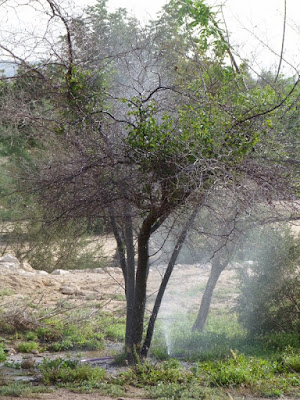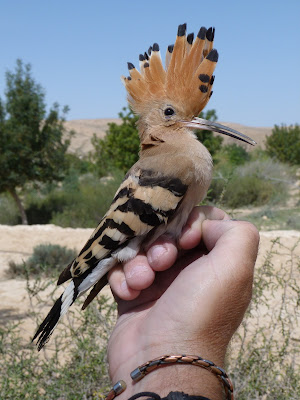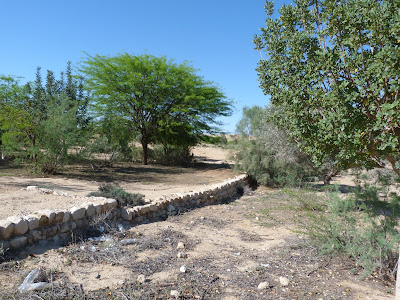Although we have found a few pairs with chicks, others were a long way behind these, still displaying - potentially some nests and/or chicks were lost in the flash floods.
Totals: 95 (4)
Common Cuckoo - 1
Hoopoe - 3
Thrush Nightingale -4
Rufous Bush Robin - 1
Graceful Prinia - 1 (1)
Reed Warbler - 2
Great Reed Warbler - 1
Eastern Olivaceous Warbler - 7 (1)
Barred Warbler - 2
Eastern Orphean Warbler - 1
Lesser Whitethroat - 5
Blackcap - 57 (2)
Pied Flycatcher - 1
Great Tit - 1
Masked Shrike -1
Greenfinch -2
After an early lunch we headed out to Ein Yorge'am again, hoping to see species that we've yet to catch up with. The pools left after the rain have now mostly dried up and tempertures reach well into the high 30s each afternoon. On arrival we saw a couple of Sinai Rosefinch, then over the next couple of hours watched the Arabian Babblers, Tristram's Grackles, Blackstart, Rock Martins, Pallid Swifts, White-crowned and Mourning Wheatears.
Arabian Babbler
The Arabian Babblers, as we have seen before, hunted individually but together as a group. This time one bird seemed to keep watch while the others fed.
Arabian Babbler
We were treated to the spectacle of two Barbary Falcons, one adult and one juvenile, hunting Rock Doves in the gorge as we left.
Tristram's Grackles panting in the shade
When we finished our walk from the gorge floor back to the car the temperature had reached 42c. This is not usual for April, being more typical of late June temperatures.
Day 13 - 23 April
In view of the high temperatures, and the fact that the area would have been packed during Passover, we decided against a trip to the Dead Sea, instead revisiting Nizzana. We hoped that the drier conditions might give up more species than our first trip.
We saw European Roller on the drive there, before we even started at the sewage works. We got Tawny Pipit while we waited for the sandgrouse to come in. This time we watched with the sun to the right of us, not so good for viewing but less intrusive to the birds. They began to arrive at 8.30am. There were a few Black-bellied Sandgrouse first then two separate groups of Crowned Sandgrouse. This time there was not a single Pin-tailed and although two poorly seen and distant birds may have been Spotted Sandgrouse, views were not sufficient to claim them - so we still have yet to see this species.
Crowned Sandgrouse
We covered the same areas as before, but this time there were no model aircraft enthusiasts to disturb the peace. We tried some additional tracks and side roads and added several species that had been nowhere to be seen before. The list now included Slender-billed Gull, Shelduck, Teal, Little Owl and McQueen's Bustard (an adult and juvenile) from Nizanna - Ezuz Road.
On the Mandtoric Road we saw some Barred Warblers, Redstart, Whinchat, Masked Shrike, Spotted Flycatcher, Cream-coloured Courser, c10 Crowned Sandgrouse (that flew over the car) and Dorca's Gazelle. So much better than the week before - just goes to show it all depends on the day.
Cream-coloured Courser
Day 14 - 24 April
Our last ringing day and we worked the mulberry trees with Yorum, Darren and Elan. As expected, the Grackles avoided the nets but we did catch a few Golden Orioles - a real challenge to age and sex! There were a few Garden Warblers that we hadn't really seen many of, and
despite it being the last day we still managed some less familiar
species such as Laughing Dove and another juvenile Palestine Sunbird.
Golden Orioles - never easy
Garden Warbler
3J Palestine Sunbird
Laughing Dove
It was fitting that among the last birds from the nets as we took down, due to heat, at 10am was a Hoopoe - the national bird of Israel.
Hoopoe - National bird of Israel
Totals: 115 (12)
Collared Dove - 1
Laughing Dove - 1
Hoopoe - 1
Thrush Nightingale - 1
Nightingale - 1
Graceful Prinia - 0 (2)
Reed Warbler -1
Great Reed Warbler - 1
Eastern Olivaceous Warbler -1
Barred Warbler - 1
Lesser Whitethroat - 5
Garden Warbler - 4
Blackcap - 87 (8)
Wood Warbler - 1
Spotted Flycatcher - 1
Palestine Sunbird - 1 (1)
Golden Oriole - 4
Greenfinch -2 (1)
Masked Shrike -1
We spent a bit of time packing and cleaning the apartment before taking one last turn around Yeroham Lake where we added Great Cormorant to our watch list.
Postscript
The next day we were invited to take a traditional passover breakfast with Yoram and Edna on the morning of our flight and it was delicious. Thank you both so much for your wonderful hospitality.
Thanks also to Francis Argyle who settled us into the accommodation and explained a few things in advance, and to Darren Burns who found some alternative sites after the first two days when the regular places were washed out and who was very patient while we struggled to identify one piece of vegetation from another, locate guys and put nets up at four separate sites, in the dark, over the fortnight. We were also unused to the extreme tension that was required on many of the nets (Francis had set up one of the alternative places - and he really like tension) and two of us had not encountered the 'Israeli knot' before - but that has now been mastered and may even be used at some of our own sites from time to time.
Thanks also to all who helped with birding information, particularly good spots for desert species.
The ringing station at Yeroham is managed through Hoopoe Ornithology and Ecology
www.hoopoe.org.il. The contact if anyone would like to spend time with the team at Yerolum is Darren (email: dazpunk77@gmail.com), who is always grateful of help, particularly at busy times of year. The organisation is keen to have more visiting ringers in the future and will help you with finding rented accommodation.
A car is really essential, as much as anything else to get to the Negev from Tel Aviv airport (about one and half hours travelling time) and as we held equipment for part of the time (especially while Darren had car trouble) it was essential for us during the visit, but would also be useful if wishing to do any independent ringing whilst visiting.
We found this a most worthwhile visit and we'd be happy to speak with anyone who is thinking about a trip to the Negev to ring with Darren at Yeroham.
https://www.facebook.com/HoopoeCenter/


























































